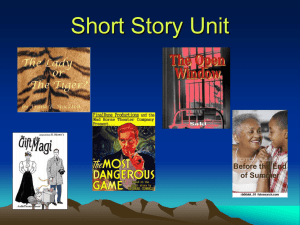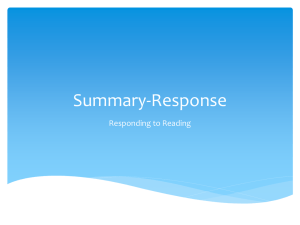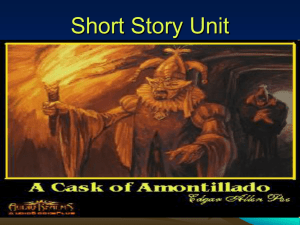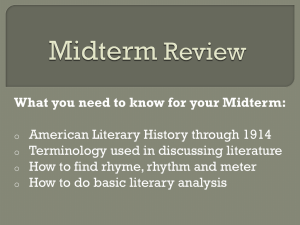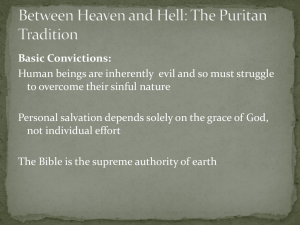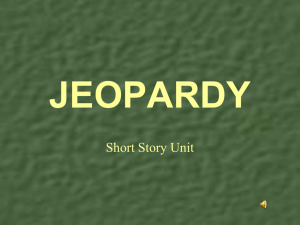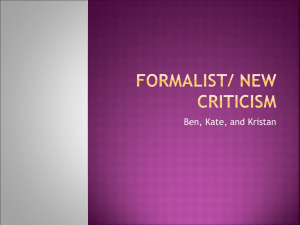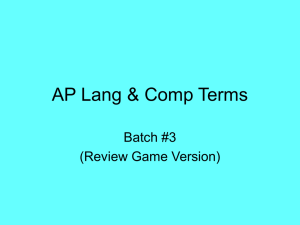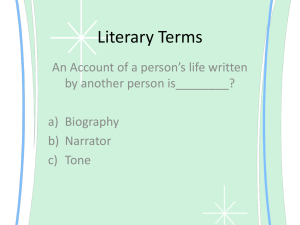Lit Element Review & Assessment Overview
advertisement
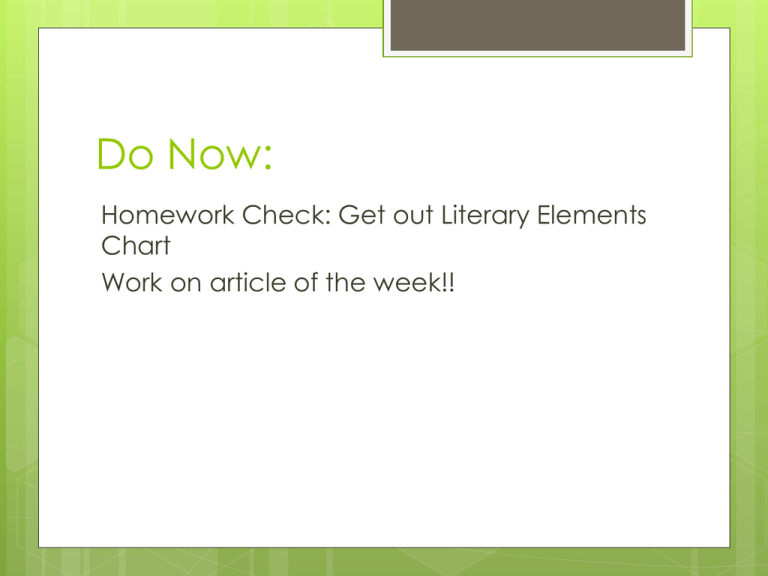
Do Now: Homework Check: Get out Literary Elements Chart Work on article of the week!! Literary Elements Chart: Literary Elements: How to Tell… Battle Royal Characterization: Direct: “…great brother she had, how together, the guy was, a number one pal and comrade. A real soldier’s soldier, Rat says” (1). Direct: “he was an odd old guy, my grandfather” (16). -Direct Indirect: Curt Lemon was an outgoing and brave man (1). --------------------------------Static: Mitchell Sanders Indirect: The narrator was respected by the white community because he was selected to deliver his speech. -------------------------------Static: blonde dancer Dynamic: Rat Kiley Dynamic: narrator Antagonist “dumb cooze”; Vietnam; War White men Protagonist Narrator (O’Brien) Nameless narrator Point of View: 1st person 1st person -Indirect -------------------------Static -Dynamic Literary Elements Chart Plot Elements How to Tell… Battle Royal Rising Action Rat Kiley (buffalo story) -arriving at the anteroom - Dancer - Battle royal -Tries to feed the baby buffalo -Shoots the buffalo’s mouth Climax Shoots off the nose and talks to it like it was a pet Narrator finally gets to give his speech Falling Action Cradles the gun Opens the briefcase to find the scholarship Resolution The other soldiers move the buffalo and don’t say anything to Rat Dream about grandfather Literary Elements Chart Literary Elements How to Tell… Battle Royal Theme Truth: “Often the crazy stuff is true and the normal stuff isn’t because the normal stuff is necessary to make you believe the truly incredible craziness” (5). Naiveté: the narrator was naïve to believe that the white community was recognizing him for his academic accomplishments. Mood Suspenseful; anxious Hostile; sympathetic Setting -Vietnam -NYC in 30’s Irony Situational Irony: The men in Mitchell Sander’s story believes that they are going to find the Viet Cong having a party when they storm the mts. but nothing is there Dramatic Irony: the reader realizes that the narrator has been brought there as the entertainment before the narrator does Diction Profanity; military jargon Derogatory language; slang -present day telling the story Literary Elements Chart Literary Elements How to Tell… Battle Royal Imagery “I remember the smell of moss. Up in the canopy there were tiny white blossoms, but no sunlight at all, and I remember the shadows...” (4). “He was a large man… that of an intoxicated panda” (20). Symbolism The woman symbolizes the general public that do not understand what war is really about The speech/scholarship symbolizes what the black community believes is progress Dialogue “Right,” I said. “Understand me?” “Invisible.” (6) “I’ll make it five more dollars.” “Go to hell.” (25) Atmosphere Mountains: spooky, dark, rainy, foggy Smoky, chaotic World Literature: Short Story Final Assessment 1. 2. 3. Overall Fiction Concepts Assessed: Response to Literature (Time Period/Culture) Genre/Structure Text Analysis Final Assessment You will be choosing a short story to read from the textbook and creating a prezi presentation where you show your understanding of fundamental and elevated fictional concepts. Within your presentation you must address the following questions: Text Analysis: 1. How does the author manipulate the reader’s reaction using literary elements? a) 2. How do I cite support from primary and secondary sources? a) b) 3. Using literary elements to analyze the text In-text citations from short story Outside research How do I understand implicit and explicit meaning in a text? a) b) Overall interpretation of the meaning of the story (plot) Analysis of Literary Elements Genre/Structure 1. How does diction and syntax shape the meaning of the text? a) Define, find examples and analysis of both diction and syntax Response to Literature: Time Period 1. How does understanding the time period facilitate the understanding of the text? a) What happened historically that influenced the author? What connects can be made between time period and the short story? Response to Literature: Culture 1. How does an understanding of an author’s culture or the culture represented in the text enhance the reader’s understanding of the text as a whole? a) What was happening culturally that influenced the author to write this short story? READ THE ASSIGNMENT SHEET & RUBRIC!!!! Timeline: Wednesday: Select title Thursday & Friday: Read short story and answer reading and analysis questions within the text book and complete literary elements chart. Monday-Wednesday: work and complete assessment in class Due date: submit to google doc by midnight December 1st. Now, you will choose your short story… You may not choose the same short story as anyone else within the class… first come, first serve. Europe: A. 1. 2. 3. 4. 5. 6. 7. 8. Short Story Selections: Brother Onion (Italy- Petrarch) p. 669 The Piece of String (France-de Maupassant) p. 796 The Long Exile (Russia- Tolstoy) p. 804 A Problem (Russia- Chekhov) p.814 The Bet (Russia- Chekhov) Tale Blazers War (Italy- Pirandello) p. 863 The Hunger Artist (Austria- Kafka) p. 869 The Ring (Denmark- Dinesen) p. 882 South America: B. 1. 2. 3. 4. Borges and I (Argentina- Borges) p. 934 The Night Face Up (Argentina- Cortazar) p. 947 Tuesday Siesta (Colombia- Garcia Marquez) p. 957 The Censors (Argentina- Valenzuela) p. 965 Africa: C. 1. 2. 3. 4. Life is Sweet at Kumansenu (Sierra Leone- Nicol) p. 986 Dead Men’s Path (Nigeria- Achebe) p. 996 The Train from Rhodesia (South Africa- Gordimer) p. 1009 The Prisoner Who Wore Glasses (South Africa- Head) p. 1023 Asia: D. 1. 2. 3. 4. 5. The Norwegian Rat (Egypt- Mahfouz) p. 1031 The Jay (Japan- Kawabata) p. 1047 An Astrologer’s Day (India- Narayan) p. 1054 Love Must Not Be Forgotten (China- Jie) p. 1062 Ocean of Words (China- Jin) p. 1083 Europe: A. 1. 2. 3. 4. 5. 6. 7. 8. 9. 10. 11. Short Story Selections: Brother Onion (Italy- Petrarch) p. 669 The Piece of String (France-de Maupassant) p. 796 The Diamond Necklace (France- deMaupassant) Tale Blazers The Long Exile (Russia- Tolstoy) p. 804 A Problem (Russia- Chekhov) p.814 The Bet (Russia- Chekhov) Tale Blazers War (Italy- Pirandello) p. 863 The Hunger Artist (Austria- Kafka) p. 869 The Ring (Denmark- Dinesen) p. 882 The Thief (Russia- Dostoyevsky) Tale Blazers The Bishop’s Candlesticks (France- Hugo) Tale Blazers South America: B. 1. 2. 3. 4. Borges and I (Argentina- Borges) p. 934 The Night Face Up (Argentina- Cortazar) p. 947 Tuesday Siesta (Colombia- Garcia Marquez) p. 957 The Censors (Argentina- Valenzuela) p. 965 Africa: C. 1. 2. 3. 4. Life is Sweet at Kumansenu (Sierra Leone- Nicol) p. 986 Dead Men’s Path (Nigeria- Achebe) p. 996 The Train from Rhodesia (South Africa- Gordimer) p. 1009 The Prisoner Who Wore Glasses (South Africa- Head) p. 1023 Asia: D. 1. 2. 3. 4. 5. The Norwegian Rat (Egypt- Mahfouz) p. 1031 The Jay (Japan- Kawabata) p. 1047 An Astrologer’s Day (India- Narayan) p. 1054 Love Must Not Be Forgotten (China- Jie) p. 1062 Ocean of Words (China- Jin) p. 1083
